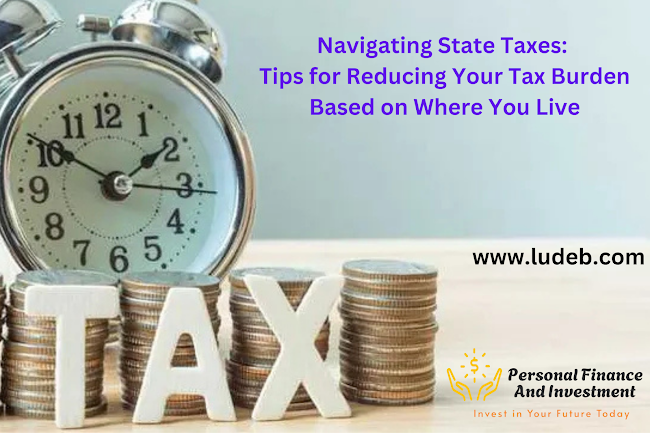Navigating State Taxes:
Tips for Reducing Your Tax Burden Based on Where You Live
State taxes in the United States can vary significantly depending on where you live, ranging from no-state income taxes in places like Florida to higher rates in states like California and New York. Understanding your state's tax structure and employing effective strategies can help reduce your tax burden and maximize your income. This article provides an in-depth guide to navigating state taxes, with practical tips and actionable advice tailored to your location.
1. Understanding State Taxes
1.1 Types of State Taxes
State taxes encompass various categories that directly impact your income and spending. The key types include:
Income Taxes:
- Most states levy an income tax, with rates ranging from 1% to over 13%.
- Seven states, including Texas, Florida, and Nevada, do not impose a state income tax.
Sales Taxes:
- Sales tax rates vary by state and sometimes by locality. For example, California has a base rate of 7.25%, but local rates can push it higher.
Property Taxes:
- Property tax rates are determined by local governments and vary widely, with states like New Jersey having some of the highest rates.
Estate and Inheritance Taxes:
- Some states, like Maryland, impose estate and inheritance taxes, while others have eliminated these taxes.
1.2 States with No Income Tax
States without income tax often compensate with higher sales or property taxes. The nine states with no income tax are:
- Alaska, Florida, Nevada, New Hampshire (taxes dividends and interest), South Dakota, Tennessee, Texas, Washington, and Wyoming.
Example Table: Tax Comparison by State
| State | Income Tax Rate | Sales Tax Rate | Average Property Tax Rate |
|---|---|---|---|
| California | Up to 13.3% | 7.25%+ | 0.76% |
| Florida | None | 6% | 0.83% |
| Texas | None | 6.25% | 1.8% |
| New York | Up to 10.9% | 4% | 1.4% |
2. Tips for Reducing Your State Tax Burden
2.1 Relocate to a Tax-Friendly State
One of the most effective ways to reduce your tax burden is relocating to a state with lower taxes. States like Florida, Texas, and Tennessee offer substantial savings for high-income earners.
Key Considerations:
- Income Level: Higher earners benefit more from states without income tax.
- Lifestyle Costs: Evaluate housing and living expenses before moving.
2.2 Maximize Deductions and Credits
Each state offers unique deductions and credits. Familiarize yourself with those applicable to your state.
Common State Tax Deductions:
- Homeowner Deductions: Many states allow mortgage interest and property tax deductions.
- Charitable Contributions: States like Arizona offer additional credits for donations to specific organizations.
- Educational Credits: States like New York provide credits for tuition expenses.
2.3 Leverage Tax-Advantaged Accounts
Tax-advantaged accounts reduce taxable income at both federal and state levels.
- Retirement Accounts (401(k), IRA): Contributions reduce taxable income.
- Health Savings Accounts (HSAs): Contributions are tax-deductible, and withdrawals for qualified expenses are tax-free.
Example: Tax Savings with a 401(k) Contribution
- Annual Contribution: $10,000
- State Income Tax Rate: 5%
- Savings: $10,000 × 5% = $500 in state tax savings.
2.4 Consider Residency Rules
Maintaining residency in a high-tax state can increase your tax liability. If you move to a low-tax state, ensure you establish clear residency:
- Register to vote and update your driver’s license.
- Spend at least 183 days in your new state.
2.5 Optimize Your Business Location
For business owners, incorporating in a tax-friendly state can reduce corporate and personal tax burdens. States like Wyoming and Nevada offer favorable tax policies for businesses.
3. State-Specific Strategies
3.1 California: Managing High-Income Taxes
California’s high-income tax rates make it essential to maximize deductions:
- Use solar energy credits to reduce taxable income.
- Claim deductions for vehicle registration fees.
3.2 Florida: Navigating No Income Tax
While Florida has no income tax, property taxes, and sales taxes can add up. Strategies include:
- Appeal your property tax assessment if your home is overvalued.
- Shop during tax-free weekends to save on sales tax.
3.3 New York: Reducing Combined Tax Burdens
New York residents face high income and property taxes. Strategies include:
- Claiming tax credits for renters.
- Contributing to New York 529 plans for college savings.
3.4 Texas: Managing Property Taxes
Texas compensates for no income tax with higher property taxes:
- Apply for homestead exemptions to reduce property tax assessments.
- Consider energy-efficient home upgrades for additional credits.
4. Navigating Changes in State Tax Laws
4.1 Monitor Tax Law Updates
Tax laws change frequently. Stay informed about:
- Adjustments in tax brackets.
- New deductions or credits.
4.2 Understand State Tax Reciprocity
If you work in one state and live in another, reciprocity agreements can prevent double taxation. For example:
- States like Maryland and Virginia have agreements for cross-border workers.
4.3 Leverage Professional Help
A tax advisor familiar with state laws can help optimize your strategy and ensure compliance.
5. Common Mistakes to Avoid
- Neglecting to File State Taxes: Even if your state has no income tax, you may still owe taxes on other earnings.
- Overlooking Local Taxes: Some municipalities impose additional taxes.
- Failing to Document Residency Changes: Without clear documentation, you may remain liable for taxes in your previous state.
6. Future Trends in State Taxation
- Digital Taxation: States are increasingly taxing online sales and digital goods.
- Green Incentives: More states are offering tax breaks for sustainable practices, such as electric vehicle purchases.
- Remote Work Implications: As remote work becomes prevalent, states may adjust residency and income tax rules to capture revenue.
7. Conclusion
State taxes can have a significant impact on your overall financial health. By understanding the tax structures where you live, leveraging deductions and credits, and considering relocation or residency changes, you can effectively reduce your tax burden. Staying informed about state tax laws and seeking professional guidance will ensure compliance while maximizing savings.


Post a Comment
0Comments